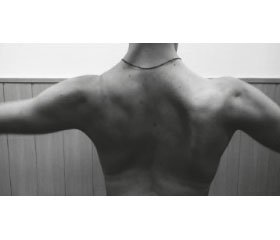Международный неврологический журнал 2 (72) 2015
Вернуться к номеру
Isolated accessory nerve impairment (clinical case, disscussion)
Авторы: Delva M.Yu., Nikiforova E.S. - Ukrainian medical stomatological academy; City clinical hospital № 1, Poltava
Рубрики: Неврология
Разделы: Справочник специалиста
Версия для печати
Isolated accessory nerve impairments are relatively rare pathology. According to the literature, isolated accessory nerve neuropathy (especially its branches) may not be diagnosed or misdiagnosed as pathology of the shoulder joint, cervical spinal roots, brachial plexus, peripheral nerves, so on.
Patient B., female, 24 years old, complained for dull pain in the right shoulder region and on the inner surface of the right arm, strange feeling "that the right arm is heavier than left", inability to shrug right shoulder and inability to abduct right arm above horizontal plane. Two months ago patient was operated for purulent cyst of neck. Two weeks after operation patient noted impaired arm abduction above horizontal plane. A week later appeared gradually right shoulder pain as well as shoulder girdle asymmetry. Patient didn’t seek medical help, the above mentioned complaints intensified progressively.
Examination. There was depression of right shoulder. The right supraclavicular fossa was deeper than the left. Active right shoulder abduction was limited up to 80 degrees. Right arm forward elevation was slightly reduced. There was moderate weakness of right trapezius muscle. There were no weakness of the sternocleidomastoid, shoulder girdle or extremity muscles. There was hypotrophy of the right trapezius muscle. The right scapula was wing-like and this sign appeared more prominent with arm abduction and practically disappeared with arm forward flexion. The range of passive movements in all joints were preserved. There were no sensitive impairments.
Electroneuromyography of upper extremities: signs of right accessory nerve axonal impairments at the level of middle third sternocleidomastoid muscle on its posterior end. There was decrease in trapezius muscle contractile properties to 16%.
Final diagnosis was established: neuropathy of right accessory nerve.
Discussion. In the majority of cases impairment of isolated accessory nerve or its branches has iatrogenic origin. Subcutaneous placement of accessory nerve in the lateral cervical triangle makes it very vulnerable during dissections in lateral triangle of the neck (due to biopsy of cervical lymph nodes along the back edge of the sternocleidomastoid muscle, due to cervical tumors excision, etc.). If there is a damage of accessory nerve in the lateral triangle of the neck it leads to impairments of trapezius muscle function only, while the sternocleidomastoid muscle remains intact.
Trapezius muscle has a fundamental role in the biomechanics of the whole shoulder girdle. When human is standing, trapezius muscle with levator scapulae muscle holds the entire weight of the upper extremity. Weakness trapezius muscle leads to the asymmetry of shoulder girdle (drooping and anterior shifting of ipsilateral right shoulder). Any impairment of trapezius muscle leads to problems with shrugging and lifting of arm in sagittal plane. But the most significant functional defect which leads to patients' disability—inability to abduct of the upper extremity above horizontal plane. Moreover, trapezius muscle weakness leads to disruption of precise movements of the shoulder-scapula complex.
As a result of paresis of the trapezius muscle the shape of the scapula is wing-like. This phenomenon is greatly enhances by abduction of the upper limb and disappears when the upper limbs are raised in the sagittal plane.
Often accessory nerve impairments are accompanied by pain of various degrees, nature and location. Pain usually worsens when patient raises arms and set its aside. As rule, there is a dull diffuse pain (but sometimes very intense) in the neck, shoulder, arm inner surface, but can irradiate even to the fingers. Cause of this pain is complex, and results in compensatory increase of tone of the levator scapulae muscle, stretching of cervical spinal roots as well as brachial plexus and shoulder joint capsule by weight of the upper limb and result in impingement syndrome.
Individual features innervation of the trapezius muscle and various compensatory properties of shoulder-scapular apparatus cause a considerable variability of the clinical picture of iatrogenic accessory nerve neuropathy. Typically, the first clinical signs appear within a few days after surgery in the form of upper limb disorder abduction above the horizontal plane, insidious pain in neck-shoulder area, and within a few weeks later appears trapezius muscle hypotrophy and wing-like scapula.
For neurologist is very important to recognize the early signs of isolated neuropathy of accessory nerve to prevent further complications of the shoulder girdle motor function. Differential diagnosis of accessory nerve neuropathy must include all the pathological processes which involve a combination of neck-shoulder pain, shoulder drooping and limitation of movements in shoulder joints (cervical radiculopathy, brachial plexopathy, long thoracic nerve neuropathy, shoulder joint pathology). On the other hand, neurologists should always be aware of the possibility of accessory nerve impairments in patients who had neck surgery (especially in lateral neck triangle).
Thus, impairments of accessory nerve in lateral neck triangle leads to dysfunction of trapezius muscle only. These peculiarities can simulate pathologies of other parts of the peripheral nervous system or pathology of musculo-skeletal system. Electroneuromyography is crucial in making proper diagnosis.

